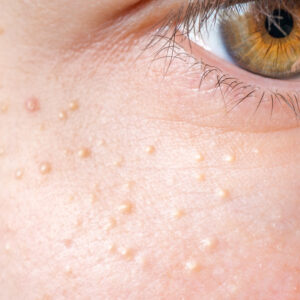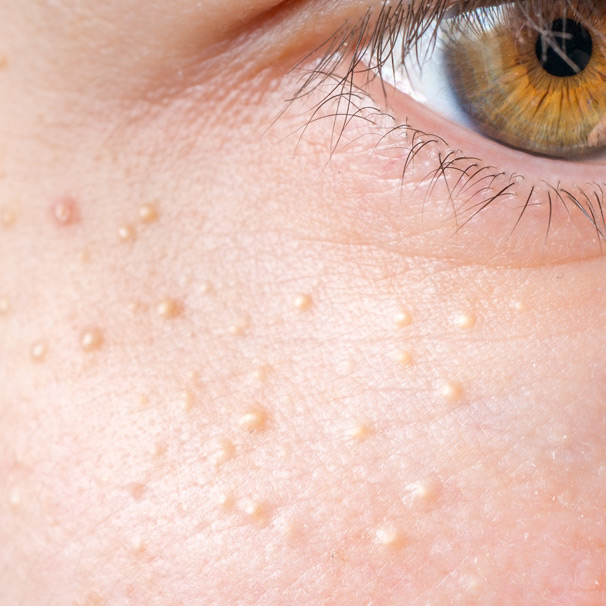All About Milia
What's with those annoying little white heads that just never seem to come to the surface and go away? What is that thick, white stuff that comes out when you finally get so frustrated you pick and poke and finally pop the bump? Milia can be the bane of your existence, particularly when they continue to form despite your best efforts at keeping your skin "clean." Unfortunately, cleanliness isn't the problem. The skin's ability to naturally exfoliate is.
Milia are deep seeded white bumps that form when skin cells become trapped rather than exfoliate naturally. The trapped cells become walled off into tiny cysts that appear like white beads below the surface of the skin. Milia can occur on the skin or even on mucous membranes such as the inner surface of the cheek or the vermillion border of the lips.
As the surface is worn away, the tiny cyst may resolve on its own, though intervention to remove the cyst may offer more rapid resolution.
Milia form for a variety of reasons. Some you can fix, but others aren't so easily dealt with. When milia do make their appearance, it is time to scrutinize your skincare routine. Although some people naturally make milia, they are often the result of a problem that has affected the skin's surface.
Skin Care and Makeup
The most common reason milia form is from smothering your skin with heavy skin care products or hair care items. Comedogenic creams and lotions may prevent the sloughing of dead epidermal skin cells. Problem products include make-up removers not labeled oil-free or non-comedogenic, hair spray, hair mousse and gel, heavy sunscreens and some moisturizers. The eyelids are very thin and more likely to experience problems with milia due to cosmetics. Re-evaluate your eye make-up and eyelid make-up remover if you are finding this to be a concern. Certain lipsticks, lip balms and products meant to help with chapped lips may be the cause of little white pearly milia developing around the edge of the lips. Again, if you see these forming, take a good look at the ingredients on the label of the products you use.
Sun Exposure
The formation of milia can also be due to cumulative sun exposure. Aging skin forms a thicker epidermis that may make it far more difficult for skin cells to find their way out of the glands. Porphyria Cutanea Tarda Milia can also be associated with certain skin diseases, particularly blistering disorders such as Porphyria Cutanea Tarda. There are other symptoms associated with these blistering diseases, such as increased hair on the face and backs of hands and knuckles. PCT is an unusual disorder. If you have milia, don't initially jump to the conclusion you have a blistering condition.
Genetics
Sometimes we just inherit certain undesirable skin tendencies.
What's a Girl (Or Guy) Gonna Do?
Exfoliation can go a long way in helping deal with milia prone skin. By keeping the epidermis thin and smooth, you can cut down on their formation. By mentioning exfoliation, I'm not talking about scrubbing off the top layer of your skin! One way is to use a gentle exfoliating microdermabrasion scrub such as DERMAdoctor Physical Chemistry Facial Microdermabrasion and Multi-Acid Chemical Peel.
Retinol is also very helpful for both fighting and preventing milia. Again, retinol should not be applied to the upper eyelids. After cleansing your skin, apply no more than a pea sized drop of DERMAdoctor Poetry in Lotion 1% Retinol no more than every other night.
If the milia won't come out on its own, it may need to be extracted by your dermatologist. In a physician's office, milia are easily removed. The skin is cleansed with some rubbing alcohol or other antiseptic. The skin overlying the milia is gently opened with a sterile lancet or needle, then pressure is applied with a comedone extractor, and the milia typically pop out.
I find that one of the most difficult areas from which to remove milia is the upper eyelid. There simply isn't a good way to press on the area and avoid the eyeball, so the lid has to be pulled either upwards or to the side, which is somewhat challenging. To prevent milia keep your sun exposure limited and always wear an oil-free sunscreen. To help remove milia, cleanse your skin with a buffered glycolic acid such as DERMAdoctor Wrinkle Revenge Cleanser to remove unwanted surface debris and cleanse the pores, also consider exfoliating and deep cleansing once or twice weekly with DERMAdoctor Physical Chemistry. Putting all of these things into practice can help speed up the process of removing current milia and preventing them from popping up in the future.
No more worrying about milia. Remove them, prevent them and enjoy bump-free beauty.



how i can prevent them.i really dont want them to cum back.wat are the cause of milia?my skin is pimple free but only bcz of milia it looks bad.
I couldn't agree more. Sometimes milia are beyond stubborn on on areas that are too dificult to remove on your own. That's when a visit to the dermatologist is quick, easy and incredibly effective. Thanks for pointing this out! It's much appreciated.
All My Best!
Dr. Audrey Kunin
The information contained in this response is intended for educational purposes only and is not meant to be used as a diagnosis or treatment plan. If you have a medical concern, please contact your physician.